Speed, Lugs and Jewel Tones: a JRJ Grass Racer
Still active today, Bob Jackson Cycles are a British builder of classic steel bicycles that is well known around the world. Less commonly known is the name JRJ Cycles that preceded it. Bob (John Robert) Jackson began building bicycle frames in Leeds, England, in 1935, offering track and road racing (time trial) models. Part of Chris Sharp's collection, this particular bike is a 1950s grass track racer that once belonged to Leslie White of the Maryland Wheelers near Belfast. The owner raced it into the late 1960s, achieving numerous victories in Northern Ireland. He then hung it up, and the bike remained untouched for over 4 decades. Today it is preserved in as-raced condition.

The JRJ name, headbadge and transfers were used exclusively until the 1960s, and still appeared into the 1980s after the switch to "Bob Jackson."
The transfers included renderings of olympic rings, the full name on the downtube reading "JRJ Olympic Cycles." As with other English "lightweight" manufacturers of that time, there was a strong emphasis on performance and competition, which explains the olympic imagery. "Always first at the finish!" was the JRJ Cycles' slogan on advertisements from the 1950s.
Traditionally, English racing frames from this era tended to be painted in saturated, jewel-like tones, known as a "flamboyant" finish. Not quite the same as pearlescent paint, the flamboyant colours are foil-like, resembling the look of candy wrappers. Bob Jackson had his favourite signature shades, including the red and blue on this bike. The blue leans toward seafoam, and the red is a raspberry-like crimson.
White lining around the lugs and fork crown highlights the elaborate shorelines.
The frame is Reynolds 531 tubing.
Grass track racing is an interesting tradition in the British Isles. In an earlier post, I mentioned how a ban on road racing from the 1890s through the 1950s led to the invention of time trials. The ban also explains the emphasis on track cycling in the UK and Ireland: Races on enclosed courses were the only kind officially permitted during this time. The grass tracks were similar to velodromes in that they were oval. However, the surface was not banked. Often the track was a multi-use field, temporarily set up for the race. Grass track racing is still done in the UK today, its popularity revived in recent years. At a grass-roots/ community level, a race like this can be organised fairly easily, wherever a flat playing field is available.
The style of races held was similar to those on the velodrome, and the bikes were fixed gear machines with track style fork-ends.
Typically the fork crown was drilled for a front brake: The rider would remove it upon arrival to the race. The tires were of course tubulars - "sew ups." Too deteriorated to hold air, the ones on this bike are original.
Also original are all the other components. Most notable among these are the English-made Chater Lea crankset and hubs, quite rare now.
The Chater Lea pedals are fitted with Brooks toe clips and leather straps.
When talking to Chris Sharp about the JRJ, I asked whether he plans to make it ridable. He has many vintage bikes, some of them quite old and storied, and he does not shy away from using them. But Leslie White's grass racer, he wants to preserve the way it is. Having met the bike's original owner, part of it is wanting to honor him. But part of it also is the history. In person, standing near this bike and touching it... There is just something so incredibly alive and exciting about how freshly used everything looks. I can readily imagine it all: a grassy field, a gray sky, a crowd of locals gathered to watch, and the riders - a blur of jewel tones against the overcast country landscape.


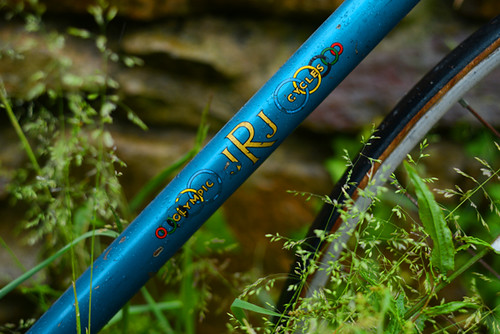
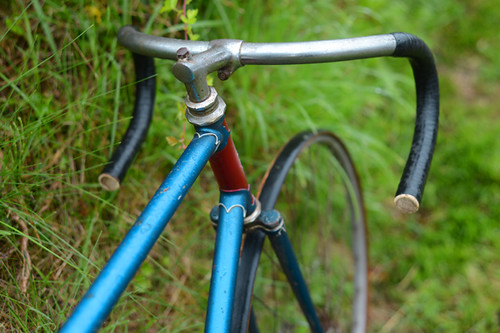
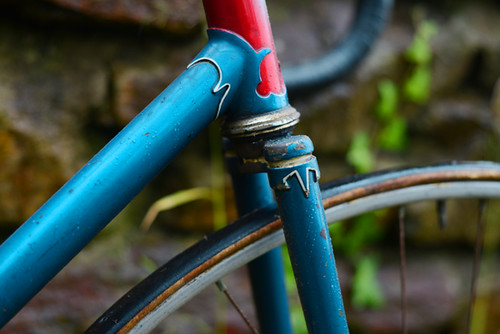

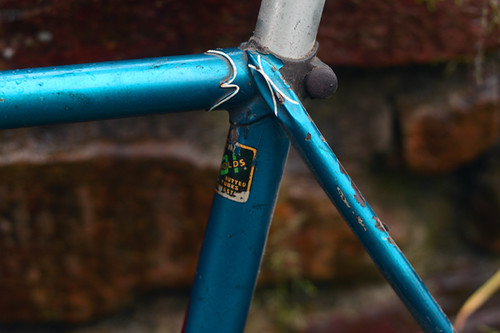

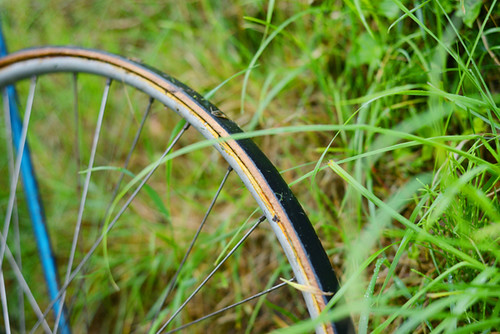
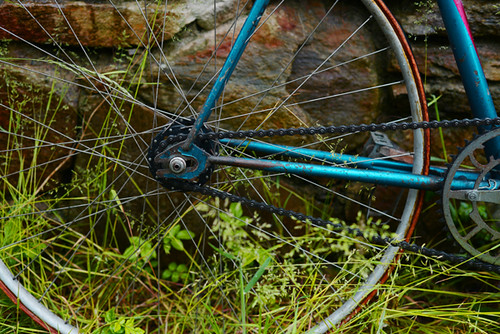
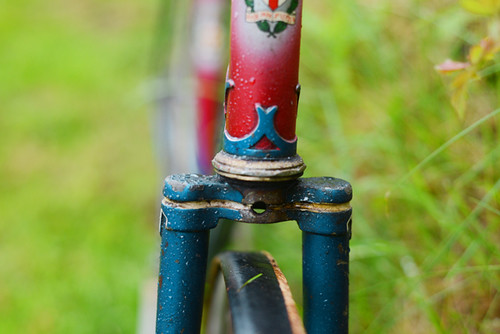
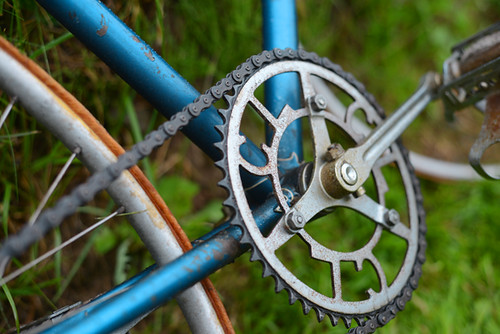
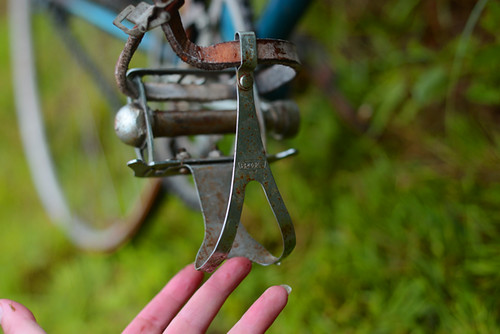
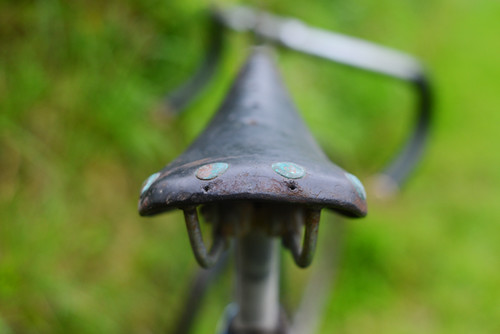
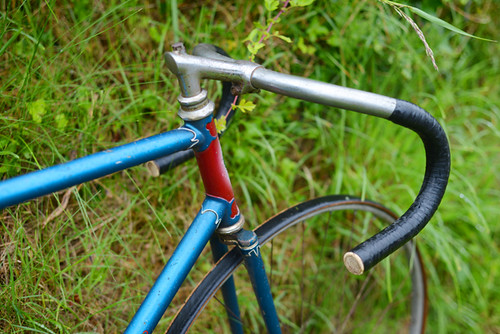
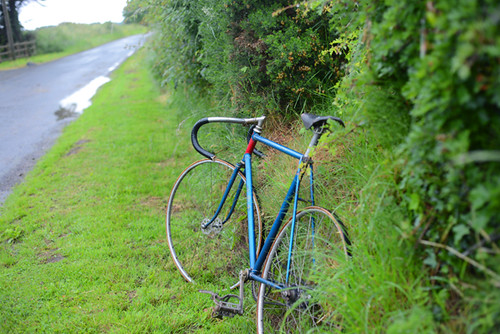
The chainstay sockets are sleeved so that a smaller diameter chainstay can be used. Maybe for some flex to keep the bike grounded over rough grass. Or maybe someone just wanted comfort. What looks unusual to me is that this feature is not paired with pencil seatstays.
ReplyDeleteFlamboyant was a multilayer job that included metal flakes followed by layers of translucent finish. As British as it gets.
Yes, that's a Cinelli stem. Positive ID from here without the stamp.
Grass track uses fairly low gears.
The gear looks high to me; I should count the teeth.
DeleteInteresting about the sockets. Talking to people, I could not get a clear idea of whether grass racers were purpose-built to begin with, or just track bikes used on grass. With this bike, I am leaning toward the former. The BB height/drop on it is not what I would expect on a velodrome track bike, but would make more sense on a grass-specific racer since the surface is not banked.
This one looks like a basic road/path to me, except for the lack of fender fitments. Grass track was sufficiently lowkey it would be unlikely to call for a special custom unless one was well-heeled and very enthusiastic. Someone may have been that into it, this looks a special bike.
DeleteLow gears so you can jump at the moment good traction appears. And not overwhelm the traction there is.
Perhaps the seat stays are the same diameter as the cs, limited to stock on hand.
DeleteThere are a few stylistic touches that are very similar to my 2000 Bob - lug outlining, slack sta, Reynolds 531.
Anyway grass/flat track racing was popular I guess around the same time with motos - empty field, let 'er run. Bmx is the natural heir to this tradition.
Nothing ever changes.
What a thought provoking post about an old bike. I did not know there was still grass racing after the 1930's or thereabouts, learned something new! I would love to find a bike like this.
ReplyDeleteThat is not at all hard to do. Look at Hilary Stone's site. I quickly count 4 frames very similar to the JRJ featured there. Three show as sold, but recently sold and certainly more will follow.
DeleteCheck Ron Boi's (13ron) current ebay auctions for complete bikes.
And there are private sales. There are trips to England and Ireland. You just missed the Ripley jumble. Make it to the York Rally.
There's a shop in my neighborhood where the owner has at least a half dozen Schwinn Paramount track bikes covering several decades beginning in the 40's (I'm guessing). I believe, at the time, these were considered amongst the best. They, too, are in original condition.
DeleteSplendid writing about a lovely bike. I have been transported.
ReplyDeleteExquisite machine, great story.
ReplyDeleteNot to nitpick, but I found a typo:
ReplyDelete"I mentioned how a ban on roadcycling from the 1890s through the 1950s led to the invention of time trials."
I think you meant to write 'ban on road racing'. Couldn't believe that the UK prohibited cycles on their roads for 60 years!
Oops! Thanks : )
DeleteWhat a fantastic machine.
ReplyDeleteI agree about not putting this one back on the road. If it hadn't been hung up after it's last battle and been used/updated/modified as things wore out, than I would say that trying to "restore" it to "as raced" condition would be impossible and a little pointless(it's only original once, ya' know) so why not put it back to work?
But since it is what it is, a genuine, very special Racer with known, specific history, laying in graceful repose in it's combat gear, let's just leave it alone and soak it up. If we ever start running out of bikes to ride we can raid the museums, but just not yet.
I forget what that Brooks model was called (B17 Sprinter maybe? Something like that) but it was a version of the B17 for track racing, there was a narrow one and for a while even an "OMG that's narrow!" version. That one looks like the OMG spec. Neat.
I also dig the way cool steel crank. There used to be a team from somewhere in Mexico that would come up to Texas to race occasionally, a bunch of juniors in old kit riding old team bikes with 5 gears, steel pedals and cottered cranks. Kicked our asses cheerfully and comprehensively. You gotta respect the crank.
Spindizzy
cottered cranks on a track bike! those were the days :)
DeleteFalcon also had Olympic Rings.
ReplyDeleteWhat a beautiful bike with such interesting history! I had no idea that grass track racing existed, but now I want to learn more about the sport (and the bikes!) - The dual lugged chainstay is especially interesting.
ReplyDeleteI've been away for some time (in the US) and haven't been reading you for over a month. I get home and check in and find that you are here (nearly). Welcome back to Ireland from a reader in County Donegal
ReplyDeleteI can practically see Donegal from my window - hi!
DeleteAnother typo: Chater Lea is without an 'r'.
ReplyDeleteThx :)
DeleteAccording to Mercian's web sight;
ReplyDelete"Flamboyant paints are translucent coloured paints sprayed in a number of coats over a silver or gold base coat. There is no pearl in the flamboyant paint itself but the sparkle and light reflections come from the base coat which shines through the flamboyant top coat in daylight." It really shows through in your photos.
I am told the original "flam" finish was a thin layer of enamel over chrome. Over time this changed to using the silver base coat. Yesterday I saw one of the early finishes. Grown faint over time, the top layer of colour enamel is almost translucent.
DeleteLove the big CL initials built right into the crank.
ReplyDeleteBritish lugs are a bit exuberant for my taste, but I can understand the appeal. The paint scheme is fun.
Did you get the make of the front hub?
The hubs are CL as well.
DeleteGreat story, Veloria. Grass track was also used as a training technique for road and track racers. Mike Barry of Mariposa/Bicyclesport/Bicycle Specialties used to run grass track races in Toronto. The resistance on the uneven, unpaved course made for an extreme workout.
ReplyDeletebertinjim
Ah! What an enjoyable post. I have a 1951 R. O. Harrison track frame and fork that is presently in the paint shop. I have the correct decals also. Beautiful curlycue lugs. I haven't decided if I will build it up or just hang it on the wall. I also have a 1957 Mcleans road/track frame that I did build up and ride. BTW, I sold my 1998 Rivendell Longlow because I got so interested in vintage British Lightweights. I have about four frames now ranging from early fifties to mid seventies. Thanks for your post.
ReplyDeleteAn acquaintance who now rides recumbent gave me an old Brooks "racing" saddle. Bill Laine of Wallingford Bicycle Parts in New Orleans was able to track down the model to an early 1950s B47. Does the JRJ saddle have stainless steel rails and aluminium cantle, the metal rear hoop to which the leather top is riveted? If so, along with the extreme narrow width, would probably make it a B47.
ReplyDelete*sigh*
ReplyDeleteOnce upon a time I had a bike with "Reynolds double butted tubing", Brooks saddle, Weinman Brakes, Campagnolo derailleur....
Alas it was stolen.
Thanks for posting this. Brought back some memories.
Roundhay grass track in Leeds, UK is banked.
ReplyDeletewww.cycleroundhay.co.uk
cool!
DeleteThe Brooks saddle is the B17 Champion Sprinter, first introduced in 1925. Certainly, a specialty saddle as it was designed for the mile and a half sprinter. ie. not for comfort but to shave weight for this short term event. Brooks specifications are for a 133mm width but modifications,with a hammer and anvil, were not uncommon.
ReplyDeleteThat must be it. I've measured it again in the widest spot and no matter where I place the ruler I can't get a figure approaching 130mm. Definitely an "OMG that's narrow" version, as Spindizzy put it above.
DeleteWhat a cool old bike!
ReplyDeleteGrass track has never quite gone away, and is alive and well in the US if you know where to look (largely smaller local clubs) and various South American and Caribbean countries.
It's fun, but scary at times, I did some a few years ago. Fixed gears, tight turns and no banking over uneven, often slippery courses means sometimes sliding and fishtailing around the turns, and, of course, crashes.
Like cyclocross, the small footprint and short race structure make it a great spectator sport, and very cheap and easy to set up (a soccer field and some traffic cones are all you need) I'm surprised it's not more popular than it is.
For all you British bike anoraks...
ReplyDeletehttp://www.classiclightweights.co.uk/
Wonderful site on British bike and cycling in Britain in the good old days.
Hi.
ReplyDeleteI have an old JRJ that i am restoring. The best badge pictures that I saw are yours. The long one I copied successfully to transfer film, but the front tube badge has lower resolution and I will re-make It on Corel Draw...the only problem is that I can not read the lower right side in the banner that says "hyde park" on the left....Could anyone tell me what says there? thanks a lot.
I think it reads Hyde Park Road Leeds 6.Possibly the address JRJ traded from. They also sold Merlin frames etc.
ReplyDeleteonly just seen this group i have an original one of these cycles for sale if anyone is interested my name is alan and my contact number is 07565296139 looking forward to hearing from you about this fabulous cycle.
ReplyDelete